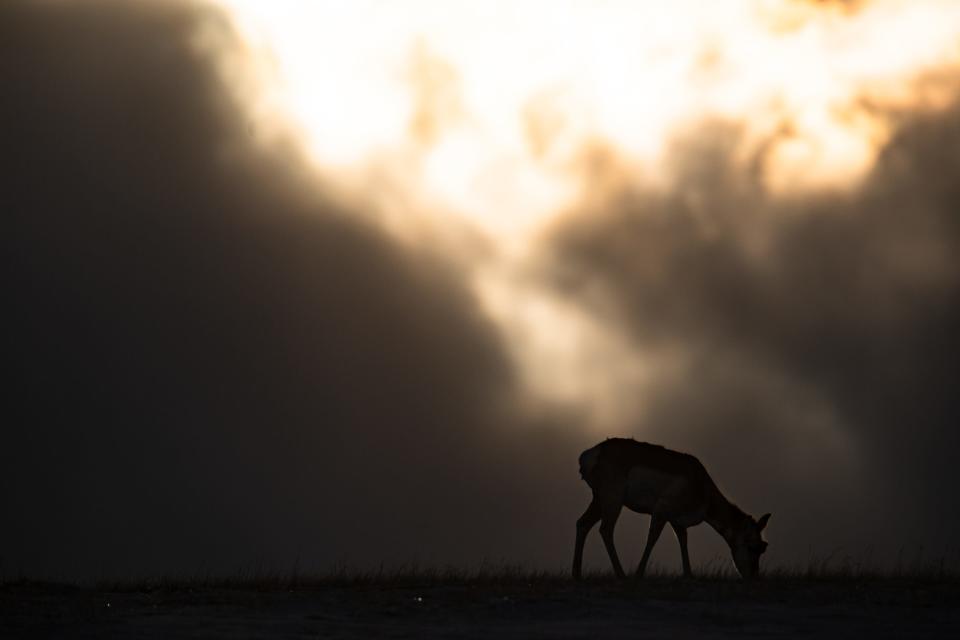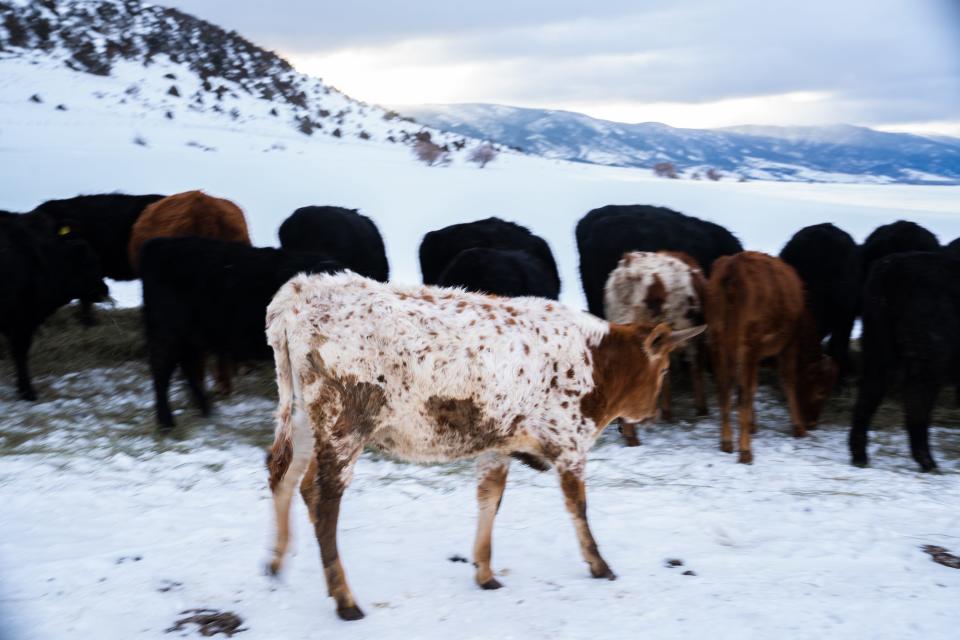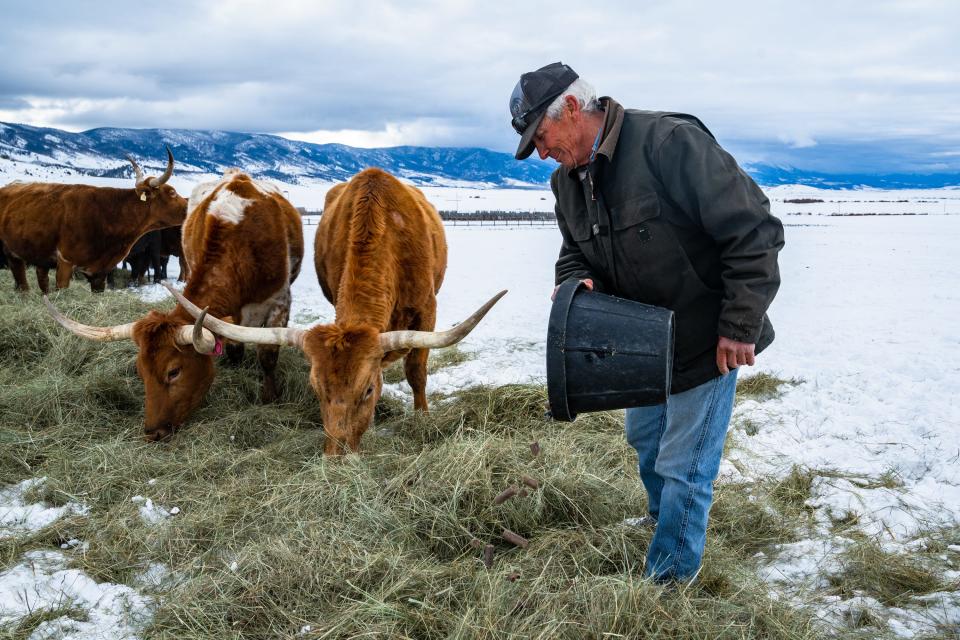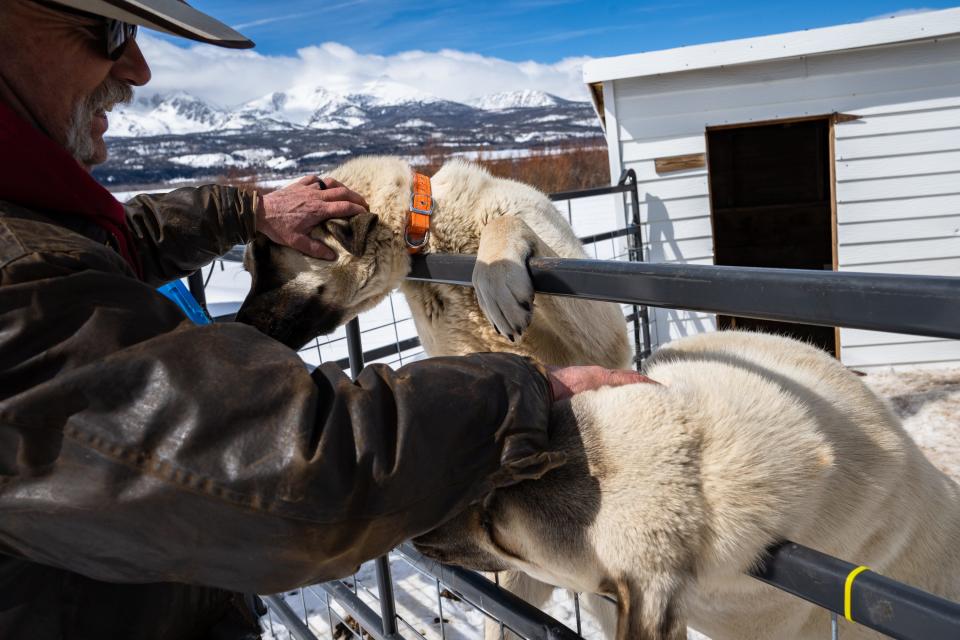What to know about Colorado's existing wolves and conflicts around reintroduction plan
A little less than two years ago, wolves in Colorado garnered little attention.
Confirmed sightings were rare, and the announcement of the lengthy planning process to reintroduce the apex predator following a narrowly approved, first-of-its-kind ballot initiative was fresh.
Much has changed since then.
Colorado has gone from two wolves that naturally migrated to the state and gave birth to six pups in northeast Jackson County — the first known pups born in the state in around 80 years in spring of 2021 — to the confirmed wolf kills of seven cattle and four dogs, fueling a firestorm of loathing by ranchers and outfitters.
And as Colorado prepares to reintroduce wolves to an area whose population largely voted against the reintroduction, frustration and tension between wolf advocates and opponents has grown, with Colorado Parks and Wildlife caught in the middle.
Here's what to know about perspectives of ranchers who have been impacted by the North Park pack, the controversy surrounding lethal control of wolves and contentious points of the state's draft reintroduction plan.
The night Colorado's long-silent war between wolves and ranchers was rekindled

Jackson County, also known as North Park, is 1,600 square miles of mountain-ringed ranch land in north-central Colorado that's dotted with 1,300 people, half of whom reside in its only incorporated town, Walden.
Ten miles northeast of Walden on the night of Dec. 18, 2021, Colorado ranchers' war with wolves was rekindled decades after the predator was largely killed off.
Rancher Don Gittleson’s worst fear after seeing occasional wolves on his 11,000-acre leased ranch over the prior year was realized the next morning when he saw what little was left of his 600-pound registered Angus calf near his house.
Colorado Parks and Wildlife confirmed the calf was killed by the North Park pack.
“My wife still has nightmares about that night," Gittleson said.
Since then, wolf depredations have ebbed and flowed in North Park, with the latest incident involving two collared wolves killing a working cattle dog and a family pet on ranches 4 miles apart March 13 and 14, further fraying nerves.
"I’m going to do everything I can to throw gasoline on this because I’ve been trying to be that guy that says, ‘OK, they’re here, let’s figure out how to live with them,' " Greg Sykes, the North Park ranch foreman whose dog, Cisco, was killed March 13, told Shannon Lukens of Steamboat Radio. "But now they’ve tied my hands. If I would have went out and found this happening, I guarantee the conversation we would be having would be through a prepaid phone card, because I would have killed the wolves. Something has to be done."
How many cattle and dogs have been killed by Colorado's North Park wolfpack?

The North Park wolfpack has killed four cows, three calves, three working cattle dogs and one pet dog from Dec. 18, 2021, to March 14, 2023. To date, the state has compensated ranchers nearly $13,000, with several cases pending and other claims denied. There is no compensation for pets, but there is for working cattle dogs.
Here are a few things to know about wolf depredations:
Studies show wolves account for around 1% of cattle and sheep deaths in Wyoming, Montana and Idaho.
Wolf depredation is a small economic cost to the livestock industry as a whole, but impacts to individual producers can be substantial.
In Montana, 17% of wolfpacks were found to have injured or killed livestock.
Wolf experts agree that once wolves kill livestock, they often continue the behavior.
Wolves kill canines such as working cattle dogs and pet dogs because wolves are territorial and view dogs as prey competition.
Human deaths by wolves are extremely rare.
Why Colorado ranchers have turned to fladry, burros and more instead of killing wolves
Wolves are listed as endangered federally in Colorado and by the state, which prohibits killing wolves unless they are threatening human life.
That's why Gittleson, with help from neighbors and the U.S. Department of Agriculture, erected turbo fladry (electric fencing with bright red-orange flagging) around his herd and was given propane cannons and strobe lights to deter wolves after his early losses.
Wolf advocates came to the ranch to watch over his herd at night. He later added cowbells around the cow's necks. Other ranches tried to train their herds to better defend themselves against wolves.
Still, confirmed wolf depredations continued over the next year on Gittleson's ranch as well as six other ranches around North Park.
So Colorado Parks and Wildlife gave Gittleson wild burros from Nevada to help protect his herd. More recently, he purchased Texas longhorns, horned Herefords and Corriente cattle, a short-horned breed often used for rodeo roping events, to ward off wolves.

"Nonlethal only works so long," Gittleson recently said. "Wolves are smart, they figure it out. Hopefully with the donkeys and horned cattle out there, it will not be as inviting to the wolves. But we need the option to use lethal means."
Johnny Schmidt is manager of Park Range Ranch, which has two locations about eight miles apart in North Park. He has used fladry and bought and trained four guard dogs to protect the ranch's cattle herd in the upper remote ranch where he figured wolves might attack.
Instead, wolves fatally injured a calf on the southern part of the ranch, which is located near other houses and busy roads around popular Lake John, in November.
"Listen, I understand wolves roam and they have to eat and so these were just doing what wolves do," Schmidt said, noting it was the ranch's first encounter with the pack. "We are trying our best to live with them. What rubs the rancher the wrong way is not that they kill our cattle, but more that we can’t do anything to defend our cattle."

Colorado had to ask the federal government to allow nonlethal hazing of wolves. Now it wants the freedom to allow some lethal control.
On Feb. 15, 2022, a California federal judge ruled management of endangered wolves transferred from some states, including Colorado, back to the U.S. Fish and Wildlife Service. That prompted Colorado to ask the federal agency for nonlethal wolf hazing options because of its wolf depredations, which was granted. Before that, wolves couldn't be hazed.
Now that wolves are federally protected in Colorado, the state has asked U.S. Fish and Wildlife Service for a 10(j) rule, which would allow more flexible management of wolves, including the use of lethal force to address depredating wolves. The question remains: Will the 10(j) rule be decided in time for wolf reintroduction by the end of 2023? Colorado State Parks and the U.S. Fish and Wildlife Service say yes. However, every 10(j) wolf rule in the past has faced lengthy litigation. Ranchers fear without a 10(j) rule in place before reintroduction their hands will be tied while more wolves hit the ground.
These are the most contentious issues in Colorado Parks and Wildlife's draft wolf recovery plan
For 18 months, Colorado Parks and Wildlife conducted an extensive process to develop its draft wolf recovery plan. It included many opportunities for public comment and the plan received around 3,000 public comments. Colorado Parks and Wildlife also convened a state-selected Stakeholders Advisory Group and Technical Working Group to help it craft the plan on which the Colorado Wildlife Commission will vote May 3-4.
Two issues have proved most contentious: lethal control and how many wolves must be in the state before their protection status changes.
Lethal control of wolves
According to the plan, nonlethal techniques should be encouraged and explored as first line of defense.
Lethal management should generally not be the initial response to conflicts except under certain conditions, which could include wolves chronically depredating or caught in the act of depredating livestock.
Wolf advocates are pressing for nonlethal to be required, not just encouraged, before lethal control can take place. They believe the plan is too vague on that issue as written.
There are mixed messages from studies regarding effectiveness of lethal control.
The plan originally included a recreational public hunting phase of wolves after a certain population threshold was attained. That has been amended to be decided by future commissions after wolf advocates strongly voiced concerns against public hunting, citing the measure approved by voters designated wolves as nongame, meaning they cannot be hunted.
Here's what one wolf advocate had to say:
“Wolves can only fulfill their ecological role if their family groups are intact and not disrupted by human persecution," said Delia G. Malone, wildlife chair for Colorado Sierra Club. "Where wolves are protected from recreational killing and lethal control, their benefits reach to enhancing biodiversity, improving climate resilience, and even enriching our own lives.''
Wolf population thresholds
The plan includes minimum population threshold phases, at which time Colorado would downlist wolves from endangered to threatened and then delist them from threatened to nongame status, which means they can't be hunted.
The plan's population threshold of delisting wolves is the most controversial. It calls for delisting after a minimum count of at least 150 wolves anywhere in Colorado for two successive years, or a minimum count of at least 200 wolves anywhere in Colorado. There is no geographical requirement for these minimums.
Wolf advocates say that threshold is not nearly enough to sustain the population and have pushed for a minimum of 750 wolves. They also want a geographical wolf distribution requirement included in the plan.
How many wolves will be released in Colorado? When and where?
Colorado's draft wolf recovery plan lays out when, where and how many wolves will be reintroduced into the state:
Initially, 30 to 50 wolves will be released over three to five years, starting in late 2023.
Those wolves are likely to come from different packs in Idaho, Montana and Wyoming.
The preferred initial release is in an area generally with Glenwood Springs on the west, Kremmling on the north, Vail on the east and Aspen on the south. A secondary release area is located directly south of the priority area, with Gunnison in the middle of that area.
The release location has concerned ranchers and hunting outfitters in that area, but Colorado Parks and Wildlife said the release site is likely not where wolves will remain and the wolves will quickly disperse, possibly 50 miles or more.
Here are the key elements of the voter-approved Proposition 114 ballot initiative
Proposition 114 passed 51% to 49%, with 17 of 22 counties west of the Continental Divide — where wolves will be reintroduced — voting against it.
Here are some key elements of the plan:
Colorado Parks and Wildlife Commission will create and carry out a plan to reintroduce and manage gray wolves by the end of 2023.
Ranchers will be fairly compensated for losses to wolves.
The Colorado General Assembly will fund the reintroduction program.
Gray wolves will be designated as nongame wildlife.
This article originally appeared on Fort Collins Coloradoan: What to know about Colorado wolves ahead of planned reintroduction

 Yahoo Autos
Yahoo Autos 